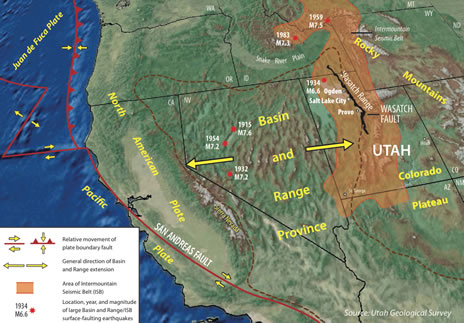Emergency Management’s mission is to ensure Salt Lake City government, its residents, and its business are invested in disaster resilience through an all-hazards approach to prevention, mitigation, preparedness, response, and recovery.
Why prepare?
Being prepared can reduce fear, anxiety, and losses that accompany disasters. Communities, families, and individuals should know what to do in the event of a fire and where to seek shelter during a tornado. We should be ready to evacuate our homes and take refuge in public shelters (SAFE neighborhoods will work as a temporary shelter in the event of the earthquake) and know how to care for their basic medical needs (we need to be trained in CERT, HAM Radio and Red Cross).

Print the 10 ways to prepare for an earthquake: 10 Ways to Prepare
- We also can reduce the impact of disasters (flood proofing, elevating a home or moving a home out of harm’s way, and securing items that could shake loose in an earthquake) and sometimes avoid the danger completely. The need to prepare is real.
- Disasters disrupt hundreds of thousands of lives every year. Each disaster has lasting effects, both to people and property.
- If a disaster occurs in our community, local government and disaster-relief organizations will try to help us, but we need to be ready as well. Local responders may not be able to reach us immediately, or they may need to focus their efforts elsewhere.
- We must know how to respond to severe weather or any disaster that could occur in your area—hurricanes, earthquakes, extreme cold, flooding, or terrorism.
- We should also be ready to be self-sufficient for at least three days. This may mean providing for our own shelter, first aid, food, water, and sanitation. Sanitation is very important. Bad sanitation is the cause of diseases during a disaster. Why Prepare (FEMA)
Utah is expecting an earthquake of a 7.0 or greater.
There is a 50% chance that will happen within the next 50 years.
Where is the Wasatch Fault?

The Wasatch fault is located in central Utah and southeast Idaho, along the eastern edge of the Basin and Range Province. (Courtesy: “Putting Down Roots in Earthquake Country”)
The Wasatch Fault parallels the western base of the Wasatch Range for approximately 350 km (220 miles), from near Fayette, Utah in the south to near Malad City, Idaho in the north. The Wasatch Fault is also known as the Wasatch fault zone (WFZ) since it isn’t a single long fault, but rather a series of fault segments. It’s no coincidence that the fault parallels the mountains; the mountains were created during the last several million years by many earthquakes along the fault zone.
The Wasatch fault zone quakes occur on normal faults that dip at an angle under the valley to the west. Repeated fault movements during earthquakes have formed the mountains to the east and the valleys to the west.
Want to know more? Visit: The Wasatch Fault ?
Disasters you could encounter in the world
- Active Shooter
- Bioterrorism
- Chemical Emergencies
- Cybersecurity
- Drought
- Earthquakes
- Emergency Alerts
- Explosions
- Extreme Heat
- Floods
- Hazardous Materials Incidents
- Home Fires
- Household Chemical Emergencies
- Hurricanes
- Landslides & Debris Flow
- Nuclear Power Plants
- Pandemic
- Power Outages
- Radiological Dispersion Device
- Severe Weather
- Space Weather Snowstorms & Extreme Cold
- Thunderstorms & Lightning
- Tornadoes
- Tsunamis
- Volcanoes
- Wildfires